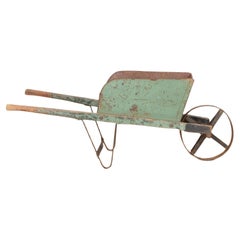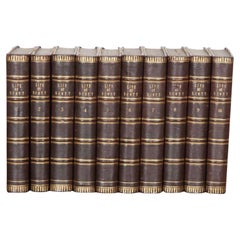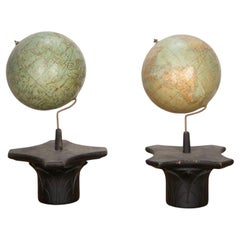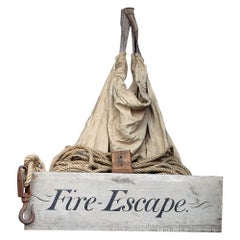J.o.e. Antiques More Furniture and Collectibles
to
3
3
1
2
2
2
2
1
1
2
2
2
1
1
3
3
3
English 19th Century Wheelbarrow
Located in Haywards Heath, GB
Rustic English 19th Century wheelbarrow.
Made of pine and metal in original paint.
Circa 1900.
Category
Antique 19th Century English Architectural Models
Materials
Pine
20th Century Leather Bound Books
Located in Haywards Heath, GB
A set of ten English leather-bound books; LIFE of SCOTT.
In lovely original condition and has very good quality gilded bindings. Circa 1900s.
Category
20th Century English Books
Materials
Leather, Paper
$545 / set
Pair of American 20th Century Globes
Located in Haywards Heath, GB
One globe of the world, one of celestial view
Made in Chicago, Illinois, USA
Category
20th Century American Globes
Materials
Pine
$946 / set
Related Items
19th Century English Quirky Country House Fire Escape
Located in London, GB
19th century English country house fire escape
We are proud to offer a rare example of a 19th century quirky county house fire escape, once of the Fasque House, Fettercaine Estate, ...
Category
Antique 1890s British Early Victorian Antiquities
Materials
Wood
French Antique Leather Bound Books
Located in Austin, TX
French antique books with Moroccan leather black spine, gold leaf imprinted title and blue and black covers. A large selection available, also in red, bl...
Category
Antique 19th Century French Napoleon III Books
Materials
Leather, Paper
Collection of 19th c. Leather Bound Books c.1822-1908
Located in San Francisco, CA
ABOUT
A collection of six 19th century to early 20th c. leather bound books.
Top to bottom:
German Church Hymnal, leather bound, Pub. 1855. Condition: Good, spine is separated from pages but still intact.
German Church Hymnal, leather bound, gilt edges, Pub. 1866. Condition: Good. Minor wear. Spine is intact.
German Bible...
Category
Antique Early 19th Century German Victorian Books
Materials
Leather, Paper
$432 Sale Price / set
20% Off
H 9 in W 6 in D 2 in
Late 19th Century English Diorama Clipper Ship Shadowbox
Located in Queens, NY
Late 19th century English Victorian painted diorama wall plaque of clipper ship with red flag painted in cloudy sky in mahogany frame.
Category
Antique Late 19th Century British Victorian Nautical Objects
Materials
Mahogany
Rare 19th Century English Tunbridgeware Hair Pin or Slide
Located in Dallas, TX
PRESENTING an EXTREMELY UNIQUE and RARE 19C British Tunbridgeware Hair Pin/Bobbin or Slide.
This slide is unlike any of it’s kind we have seen before, it is a VERY RARE survivor.
From circa 1860 – 80 and made in Tunbridge Wells, England.
Made of walnut with gorgeous marquetry inlay on the entirety of the front with classic Tunbridgeware micro-mosaic all over the front. The rear is walnut.
The marquetry inlay appears to be various different woods, namely, maple, walnut and satinwood.
Would have been worn in a Lady’s hair bun with the micro-mosaic facing forward.
This would have belonged to a VERY ELEGANT LADY in the mid to late 19th Century.
Tunbridge ware is a form of decoratively inlaid woodwork, typically in the form of boxes, that is characteristic of Tonbridge and the spa town of Royal Tunbridge Wells in Kent in the 18th and 19th centuries. The decoration typically consists of a mosaic of many very small pieces of different coloured woods that form a pictorial vignette. Shaped rods and slivers of wood were first carefully glued together, then cut into many thin slices of identical pictorial veneer with a fine saw. Elaborately striped and feathered bandings for framing were pre-formed in a similar fashion.
There is a collection of Tunbridge ware in the Tunbridge Wells Museum and Art Gallery in Tunbridge Wells.
The famous makers of Tunbridge ware were in the Tunbridge Wells area of Kent; their most notable work was from circa 1830-1900.
Early makers of Tunbridge ware, in Tunbridge Wells in the mid-18th century, were the Burrows family, and Fenner and Co. In the 19th century, around 1830, James Burrows invented a technique of creating mosaics from wooden tesserae. Henry Hollamby, apprenticed to the Burrows family, set up on his own in 1842 and became an important manufacturer of Tunbridge ware, employing about 40 people.
Edmund Nye (1797–1863) and his father took over the Fenner company when William Fenner retired in 1840, after 30 years in partnership with him. Thomas Barton (1819–1903), previously apprenticed at the Wise factory, joined the Nyes in 1836, and worked as Nye’s designer; he took over the business in 1863 and continued there until his death.
In Tonbridge (near to Tunbridge Wells), George Wise (1703–1779) is known to have had a business in 1746. It continued with his son Thomas, and Thomas’s nephew George (1779–1869), who took over in 1806. In its early years the company made articles such as workboxes and tea caddies with prints of popular views; later items had pictures created from mosaics. Their workshop in Tonbridge, Wise’s Tunbridge Ware Manufactory, was next to the Big Bridge over the Medway; the building was demolished in 1886 to widen the approach to the bridge.
Tunbridge ware became popular with visitors to the spa town of Tunbridge Wells, who bought them as souvenirs and gifts. Articles included cribbage boards, paperweights, writing slopes, snuffboxes and glove boxes.
At the Great Exhibition of 1851, Tunbridge ware by Edmund Nye, Robert Russell and Henry Hollamby was shown; Edmund Nye received a commendation from the judges for his work. He exhibited a table depicting a mosaic of a ship at sea; 110,800 tesserae were used in making the picture.
The manufacturers of Tunbridge ware were cottage industries, and they were no more than nine in Tunbridge Wells and one in Tonbridge. The number declined in the 1880s; competent craftsmen were hard to find, and public tastes changed. After the death of Thomas Barton in 1903 the only surviving firm was Boyce, Brown and Kemp, which closed in 1927.
Marquetry was an old technique which was continued by Nye and Barton to create images such as birds or butterflies.
‘Green Oak’ as caused by the fungus Chlorociboria aeruginascens.
Stickware and half-square mosaic was invented by James Burrows in about 1830: a bunch of wooden sticks of different colours, each having triangular or diamond-shaped cross section, were tightly glued together; in the case of stickware, the resulting block was dried, then turned to form an article such as the base of a pincushion. For half-square mosaic, thin slices were taken from the composite block, and applied to a surface.
Tesselated mosaic, was a development by James Burrows of half-square mosaic; it was adopted by George Wise and Edmund Nye. Minute tesserae were used to form a wide variety of geometric and pictorial designs.
Many sorts of wood were used for the various colours; about 40 were in regular use. Only natural colors were used; green was provided by “green oak”, produced by the action of fungus on fallen oak. Designs for articles were often taken from designs of Berlin wool work.
Category
Antique Late 19th Century English High Victorian Collectible Jewelry
Materials
Satinwood, Walnut
Early 20th century leather bound book entitled Rubaiyat of Omar Rhayyam, C 1910
Located in Central England, GB
This superb and most eyecatching leather bound library edition of the famous translation of the Rubaiyat presented by Willy Pogany, published by George G Harrap and Co Ltd, London, w...
Category
Early 20th Century British Edwardian Books
Materials
Leather, Paper
$412
H 8.86 in W 6.3 in D 0.79 in
19th Century English Folk Art Encased Ship Diorama
Located in London, GB
19th Century Folk Art Encased Ship Diorama
A delightful and highly decorated example of a late 19th century English folk art ships model diorama...
Category
Antique 19th Century British Folk Art Nautical Objects
Materials
Glass, Wood
Pair of Late 19th Century English Riding Boots
Located in Chicago, IL
This striking pair of late 19th-century English black leather riding boots is a handsome relic of the sporting life. Crafted with exceptional care, the boots retain their original fo...
Category
Antique Late 19th Century English Edwardian Sports Equipment and Memorab...
Materials
Leather, Wood
$1,350 Sale Price / set
25% Off
H 24.5 in W 11.5 in D 3.5 in
20th Century Pair of Italian Obelisks, Hand-Painted Porcelain
Located in Southall, GB
Pair of highly decorative, hand painted porcelain obelisks. Wonderful vibrant colour decoration with cherubs on plaques.
Category
20th Century Italian Obelisks
Materials
Porcelain
$1,731 Sale Price / set
20% Off
H 25.5 in W 6 in D 6 in
English Stick Barometer by Loftus, London, 19th Century
Located in Savannah, GA
A late 19th century rosewood stick barometer by Loftus of London.
3 ¼ inches wide by 36 inches tall; 3 inches deep
Category
Antique 19th Century English Scientific Instruments
Materials
Rosewood
Pair of 20th Century Italian Room Divider Panels
Located in Gloucestershire, GB
A stylish pair of 20th Century Italian brass room divider panels.
In the Brutalist style. Standing on small cylindrical legs.
Circa 1975.
Category
Late 20th Century Italian Brutalist Screens and Room Dividers
Materials
Brass
Early 20th C. Classical Style Globe
Located in Los Angeles, CA
Vintage globe mounted on a mahogany wooden stand with three elegantly turned legs. A brass colored meridian ring encircles the globe, adding to its antique aesthetic. The wooden st...
Category
Vintage 1940s American American Classical Globes
Materials
Mahogany




